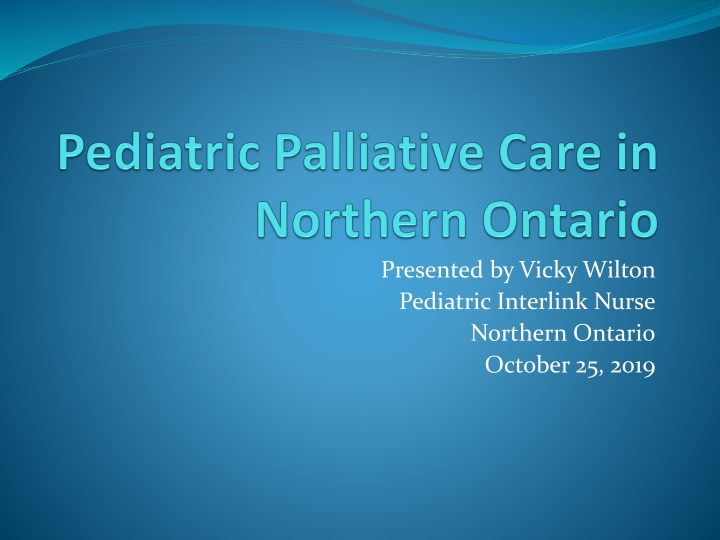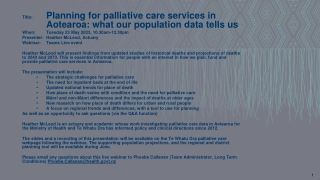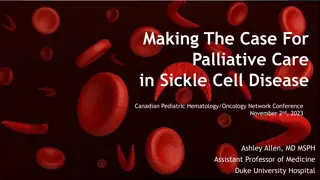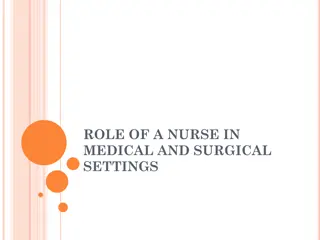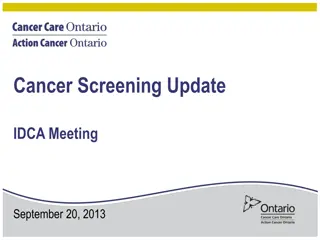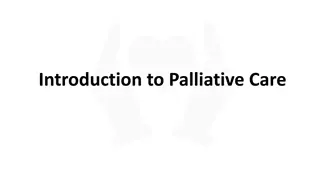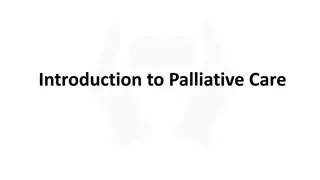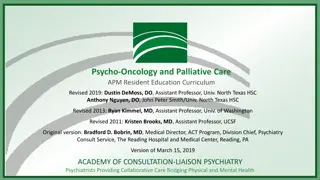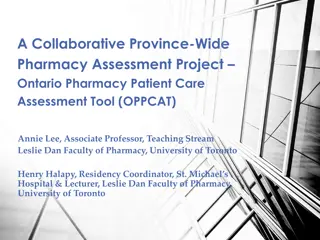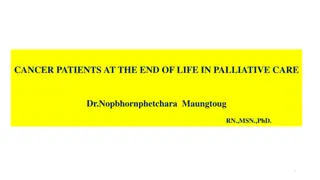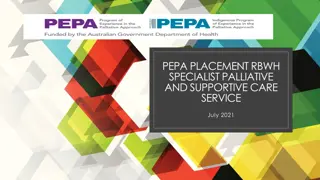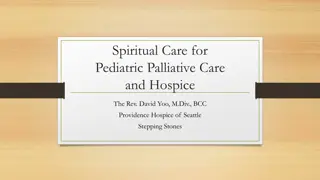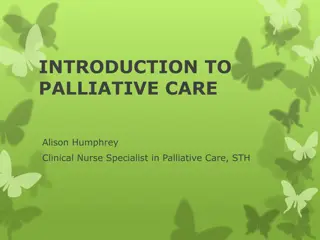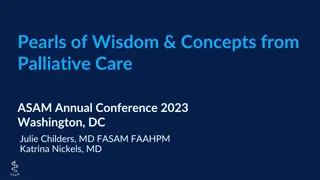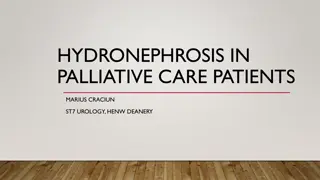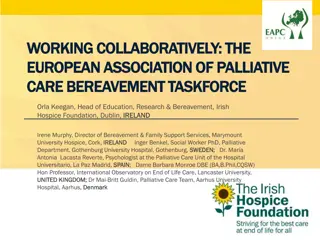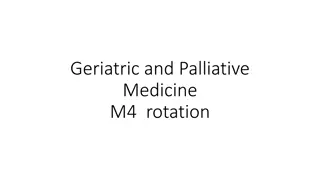Pediatric Palliative Care and the Role of Interlink Nurses in Northern Ontario
Vicky Wilton, a Pediatric Interlink Nurse in Northern Ontario, presented on pediatric palliative care focusing on identifying differences and similarities between pediatric and adult care, integrating advance care planning, and emphasizing hope. The role of Pediatric Interlink Nurses within the Pediatric Oncology Group of Ontario involves linking services for children with cancer at hospitals, homes, and schools, beyond just palliative care. The Sudbury POGO Satellite Clinic collaborates with major healthcare institutions to provide pediatric oncology care in Northeastern Ontario, emphasizing the transferability of palliative care concepts to various pediatric illnesses and diseases.
Download Presentation

Please find below an Image/Link to download the presentation.
The content on the website is provided AS IS for your information and personal use only. It may not be sold, licensed, or shared on other websites without obtaining consent from the author.If you encounter any issues during the download, it is possible that the publisher has removed the file from their server.
You are allowed to download the files provided on this website for personal or commercial use, subject to the condition that they are used lawfully. All files are the property of their respective owners.
The content on the website is provided AS IS for your information and personal use only. It may not be sold, licensed, or shared on other websites without obtaining consent from the author.
E N D
Presentation Transcript
Presented by Vicky Wilton Pediatric Interlink Nurse Northern Ontario October 25, 2019
Disclaimer No conflict of interest to declare I am affiliated with a charity for children with cancer (Northern Ontario Families of Children with Cancer)
Objectives Identify the differences and similarities between pediatric and adult palliative care Intergrade advance care planning for pediatric palliative care patients/families Discuss the significance of hope when caring for pediatric palliative children
What is the Role of the Pediatric Interlink Nurse? Pediatric Community Cancer Service of the Pediatric Oncology Group of Ontario (POGO) which is funded by the MOHLTC) Ontario based with 10 nurses covering all of Ontario (Toronto (3), London (1), Hamilton (1), Barrie (1), Ottawa (2) and Sudbury (1) * Northern Ontario Nurses that are experienced in caring for children with cancer and their families Understand the challenges of facing cancer Members of the hospital and clinic teams and work to link services at hospital, home and school More than palliative care
Sudbury POGO Satellite Clinic POGO is the Pediatric Oncology Group of Ontario which is the governing body for pediatric oncology in Ontario System of care for pediatric oncology care in the province- 5 tertiary centers and 9 satellite clinics We have a pediatric oncology satellite clinic in Subury serving Northeastern Ontario. Collaborate with CHEO, Hospital for Sick Children and London Children s Hospital Our staff consists of 2 clinic nurses, 2 physicians and 1 Interlink Nurse
Not Just Pediatric Oncology Since cancer is the #1 cause of death from disease of children, and we work in oncology, we have PPP experience Believe that any clinician that is willing, can provide good care with the right tools and resources. We feel that the ideas, thoughts, planning and care of children that are palliative, are transferrable to other children with diseases, illnesses, injuries etc. It applies to all children in this situation
Goals Goal is to have all children (0-18 yrs) die in the setting that they desire (hospital, home, hospice) with the appropriate nursing, physician and allied health care professionals available to them Children's last wishes to die at home should not be compromised because health care providers, MHLTC, LHINS can t provide the service Difficult for children/families to understand the current status of health care in Northern Ontario Difficult to tell a child they can t die at home due to lack of services Trying to build capacity in Northern Ontario Our children deserve competent care in the place of their choice
WHO Definition of Pediatric Palliative Care Palliative care for children is the active total care of the child s body, mind and spirit and also involves giving support to the family. It begins when the illness is diagnosed and continues regardless of whether or not a child receives treatment directed at the disease. Health providers must evaluate and alleviate a child s physical, psychological and social distress. Effective palliative care requires a broad multidisciplinary approach that includes the family and makes use of available community resources; it can be successfully implemented even if resources are limited. It can be provided in tertiary care facilities, in community health centers and even in children s homes. WHO (1998)
Highlights Care is total, all aspects of child and family Care extends to child s family which enhances care delivered to the patient Care ideally starts at time of diagnosis (this piece is difficult with children) and continues through the trajectory of treatment, palliation, end of life and bereavement Place of care ideally is at the preference of the child/family *this approach requires proper networking with local medical facilities, home care, hospice and providers Multidisciplinary approach is imperative When families are involved in the decision making process it has been associated with an increased sense of control and healthier grieving
Current Situation in Northern Ontario Obviously depends on where you live In rural and remote areas the child is usually cared for in the closest hospital In larger centers they have a little more choice (home, hospice, hospital) Some families choose to go back to their tertiary centers. demonstrates lack of trust, connections with their community providers *diagnosis related The care is provided by pediatricians, adult palliative care teams, family physicians, and nurse practioners
Similarities between Adult and Pediatric Palliative Care (WHO) PPP is based on the same principals of palliative care Provide relief of distressing symptoms Intended to neither hasten or postpone death Integrates the psychological and spiritual aspects of care Offers a support system for the patient and family Uses a team approach Enhance the quality of life
Differences Between Adults and Children Pediatric palliative care is based in the same principals as adults but also recognizes the unique needs of families faced with a child s illness and death. Children and adolescents are in a process of development (physical, emotional, cognitive, and spiritual) they have different skills and needs. Children communicate differently; their understanding of illness, death and dying depends on their stage of development/experience Children are members of many communities, including families, neighbourhoods, and schools. Continuing their role in these communities should be incorporated into their dying journey. (eg: doing homework if they are able) They are often known to the entire community and this is a blessing and a burden to families
Differences Continued Children respond differently to therapies and drugs. They experience and express pain differently than adults and require individual treatment Children are not able to advocate for themselves and rely on family members to make decisions for them. Parents have a heavy responsibility for the care of their child. They often have to make decisions in the best interest of the child when they are highly stressed (financial/time spent with other children) and grieving (loss of child s health) Many of these life threatening conditions are very rare and the child and family feel very alone in their suffering.
Differences Continued There is a lot of guilt associated for parents: delayed diagnosis, unable to protect or save them, heridity, made wrong decisions The grief associated with the death of a child has devastating, long term implications for the entire family Out of the natural order Children have a long trajectory to death Most PPC patients are alive > than 1 year after initiating palliative care services. Mean time to death is approximately 2 years Consent, capacity and best interest
The Role of Adult Hospices in Pediatric Palliative Care There are very few hospices dedicated to pediatrics in Canada. There are only 2 in Ontario Emily s House Toronto Roger Neilson House Ottawa This leaves the rest of the province lacking in pediatric hospice care In Sudbury we have collaborated with the adult hospice (Maison McCulloch Hospice) to allow children to receive hospices services there this was a 2 year process of a detailed planning starting with discussions with management, introducing the concept to staff, providing initial and ongoing education and support, and being present when children become residence at the hospice Feel that this can happen within any hospice with planning and support As a team, we also introduce hospice care to families and children as an option at an early stage
General Ideas to Keep in Mind Meet parents where they are Collaborate with teams members > we need each other Parents have to know that everything that could be done was done> they have to live with the decisions and consequences they have made after their child dies Parents must feel that their child s wishes were recognised and respected Family centered care Who is considered their family?
Timing of Understanding That Child Had No Realistic Chance for Cure Illness Trajectory Physician - 206 days Parents - 106 days Wolfe, et al 2000
Importance of Hope in PPP Hope is a multidimensional concept that is important for all parents of children with cancer. However, most work has focused on advanced cancer and poor prognoses Study (N 374 patients) examined hopes of all parents of children with cancer longitudinally during the first year of treatment. Parents need to know that they did everything they could but this tendency must be weighted against the burden felt by the dying child (painful procedures, isolation etc.)
Hope Study showed that: Fifty-five percent of parents reported being extremely hopeful in general at baseline. Hopefulness did not significantly change over time, and most parents reported being extremely hopeful regardless of prognosis. Most parents considered hope for cure to be an extremely important source of hope; most also reported hope that the child would feel loved, that the child would have the best possible quality of life, and that they would always do all they could for the child. Hope for cure was slightly lower among parents of children with less than a 50% chance of cure at baseline when compared to those with better prognoses Hope not just for cure. This hopefulness persists over time, even when the prognosis is poor. Clinicians should focus on supporting the myriad hopes that contribute to overall hopefulness For many families having hope is the only way they can cope with the situation it keeps them going
Advance Care Planning (ACP) Assess the needs of the child and family, a plan should be developed along with them Establish who is the substitute decision for the child not always clear Provide appropriate written information to back up discussions and plans Assess medication and discontinue anything considered non-essential Ensure family has contact information that is clear, available and review it with them (Doctor, Case managers, Interlink Nurse, nursing agency, funeral home etc.)
ACP (continued) Allows family to express their wishes and choices surrounding end of life Discuss the issues of resuscitation and care in the case of acute deterioration (DNR) Have a DNR in place with copies for all family members caring for the child Conversation about tissue and organ donation Symptoms management plan need to be put in place> symptom management kit if applicable Discuss preferred place of death
ACP (continued) Consider cultural and spiritual wishes and discuss with family prior to end of life Review their options, which in Northern Ontario are limited home, hospital, hospice
Limited Resources for Pediatric Palliative Care Providers There is very little literature published on pediatric palliative care (PPC) Limited research into PPC Oncology teams become competent from experience by default
Cure Focused Education and Training Almost all training and orientation of clinicians is nearly wholly focused on finding out what is wrong with a patient and directing efforts to fix it Clinicians experience great role ambiguity and helplessness when shifting goals of care from treatment to symptoms management At times the sadness clinicians experience can be significant and profound Despite the sadness clinicians have inherent satisfaction through the provision of pain and symptom relief, comforting physical care and psychosocial and spiritual support
In Northern Ontario We Need to Work Together! We need to connect our palliative care and pediatric care expertise Identify and create a network of interested practitioners in Northern Ontario All to reach our goal to allow children and their families a choice
Considering Best Interests For the majority of pediatric palliative patients substitute decision-makers are required and parents are usually the best people to fulfill this role Parents (guardians) are expected to make decisions that are in the best interests of the child and to take into consideration any wishes the child has expressed Clinicians play an important role in helping parents and others with this task Decisions are best made through collaboration and consensus- building The goal is to combine the clinicians knowledge and experience with the understanding, values, beliefs and expectations of the patient and parents to achieve optimal outcomes for the patient
Considering Best Interests In addition to this collaborative work with parents , clinicians are ethically and legally responsible for ensuring that the decisions made are in the best interests of the patient However there is no universally agreed upon definition of best interests and this leads to the majority of the disagreements and conflict between parents and healthcare professionals during the decision making process This can me minimized when each person involved is open to the perspectives of others and recognize that everyone is doing everything in their power to ensure that the child s best interests are served
Assessing Capacity An individuals right to make a decision for themselves is legislated on the basis of age or life experience In Ontario there is no legislative age of consent for medical treatment Legislative jurisdictions support the use of competence or capacity rather than age or life experience as the standard The child must understand the proposed interventions and their consequences, then they are considered competent or capable of making their own decisions
Assessing Capacity The patient must: Know that there is a decision to be made and be able to receive and appreciate information necessary for making that decision Be able to understand the potential consequences of the decision Be willing to make a decision Be able to communicate the decision by some mode Be able to intergrade the information in such a way as to produce the decision Be able to weigh conflicting factors in a decision and reach a resolution by application of a stable set of values or priorities
Informed Choices Palliative care choices must be informed choices Informed decision-making is best achieved when there has been ongoing process of disclosure and family education, along with mutual exploration of the child, family and healthcare professional s expectations, perceptions, misperceptions, beliefs and values. Clear understanding and true informed choices can be achieved through this process An informed choice consists of 4 components: capacity of decision maker, disclosure of all information, understanding, volunteering decision making
Never Black and White o Complicated situations .. o Adolescence that have been deemed capable of making their own decision but this decision is not in agreement with parents o Need to be collaborative with all involved o Adolescent needs support and encouragement o We often facilitate the conversation between the teen and their parents
Legacy Building o How will the child be remembered? o What can we do in advance? o Hand molds o Family pictures o Videos o Crafts o Memory box o Custom made earns and headstones
Talking to the Child and Siblings o Study in 2016 that asked siblings of children cancer for advice to health care professionals o Give better medial information o Allow them to be more practically involved with care o Guide parents on how to involve siblings o Mediate hope along with realism o Consult with parents to find out what they have told the child and how they have explained it o Speak to the child at their level of understanding o Be open and honest, always use the correct terminology o Talk about the practical aspects of the situation to enhance understanding o ie. Unable to eat or drink, walk, talk
Children age 3-6 o View the world from the perspective of their own experiences o They do no clearly understand the concept of death and dying o They see death as a departure or separation (they know the person is gone) vs a permanent absence o They believe death is reversible (see this on TV/movies) o Magical thinking and fantasy reasoning are characteristic of this age group o They are convinced of the power of their wishes, they believe they can will a person back to life
Children age 3-6 o They also believe that thoughts, words or actions can cause death to occur o They also believe that death is a punishment o Children this age associate death with darkness, violence, evil and sleeping. Therefore nightmares and fear of the dark can be common
Children ages 6-10 o These children gradually come to understand and accept that death is final and universal o They accept the fact that a person has died and will not come back, but do not grasp that everyone will die including themselves (middle ground) o Still have magical thinking and overestimate the power of their wishes o At this age they associate death with ghosts, witches, and monsters (questions who killed them?) o Fear of bodily injury and pain o Seek information about death and bodies
Age 6-10 continued o Establish own sense of moral judgement (right vs. wrong) o Still believe it may be caused from something they did, said, or thought o Begin to reason out the meaning of life and think about the possibility of an afterlife
Children age 10-12 o Develop an acute sense of what is wrong or right o Still consider death as a punishment o Also still have magical thinking o They are beginning to understand the biological and emotional aspects of death o Better able to understand the facts surrounding death vs the associated feelings around it o They understand that death is caused by illness, accidents or old age o They tend to focus on who will fill the role of the person in the family/house? o They will begin to think about their own death o They consider death in spiritual terms o Death is understood to be irreversible, real and universal
Children age 12-18 o Understand the concept of death o Focus on meaning of life o They are focused on the here and now but at the same time think about their future o For teens, thoughts of death or their own mortality may be too threatening or overwhelming and therefore sometimes try to defy death o They often do not want to talk about it although they know they are dying
Pain o Pain for pediatric patients has multiple factors (which can be similar to adults) o Age, gender, temperament and cultural (stable) o Cognition (understanding the disease), Perceived control, Behavioral (staff responses, untreated side effects), Social isolation, Emotions (depression, anxiety, fear of death) (modifiable) o Any attempts to positively change these factors are likely to have a positive impact on pain control o Pathophysiology of pain is similar to adults
Pain Assessment o Accurate assessment is essential for correct management o Measured by a child s behavioral response (facial response) or physiological response (tachycardia or self-report) o Assessment also includes: questioning the child, using a pain-rating scale, evaluate behavior, physiological changes, parental input, and cause of pain
